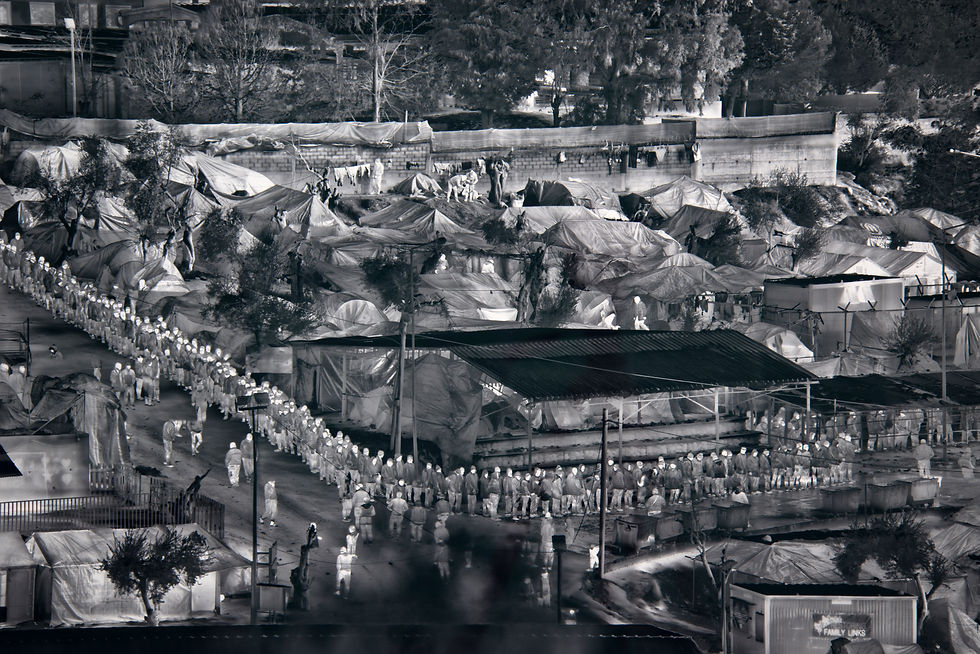STREAMING MUSEUM
Arts · Technology · World Affairs
Hello 2022.
Kindness, Key to Survival
Exhibition features: Richard Mosse's photography series Infrared on beauty and tragedy in war and destruction; Incoming on mass migration and human displacement / Mass for the Endangered, "breathtaking beauty" by composer Sarah Kirkland Snider / Michael Najjar's supersymmetric particles hybrid photograph of The Large Hadron Collider, searching for the inner structure holding the world together / Stephanie Castonguay, sound artist's Capturing Light and Sentient probes circuits as the closest way to touching the stars from a distance / Land Art Generator’s renewable energy landscapes are large-scale works of art / Debbie Symons’s extinction data visualization 1975 - 2100 / Sadalsuud by composer Emanuel Pimenta and filmmaker Dino Viani's portrait of people around the world isolated during the pandemic / When the Time is Right an NFT by David Bates, Jr

Shahzia Sikander, The World is Yours, the World is Mine, 2014
Kindness, Key to Survival, essay by Daniel M.T. Fessler Ph.D.
Director of the UCLA Bedari Kindness Institute and Professor of Anthropology, University of California, Los Angeles. kindness.ucla.edu
Our species is fundamentally social, meaning that, throughout our evolution, humans and their predecessors have relied on living in groups to survive. In turn, sociality involves an ever-present tension between self-interest and cooperation. Both biologically evolved human nature and
culturally evolved institutions reflect this tension. These two factors converge in that we are most inclined to be altruistic toward those who are like ourselves and are urged to do so by cultural norms. Similarly, we are inclined to see others who are unlike ourselves as competitors, and often, cultural norms urge us to view them this way. As a result, from neighborhoods to nations, people find it easier, and often more rewarding, to be kind toward members of their in-group, and easier, and sometimes rewarding, to aggress against members of out-groups.
We readily construe crises as competitions, and we easily lay blame at the feet of outsiders. Yet, at the same time, we are capable of remarkable unity, of oneness of purpose, and of shared sacrifice toward the common good.
At the UCLA Bedari Kindness Institute, scholars from a wide variety of disciplines are researching the factors that promote or hinder kindness, at scales ranging from individual psychology to international diplomacy. We do so motivated by the firm belief that kindness holds the key not only to humanity’s wellbeing, but to our very survival.
Kindness, Key to Survival by Daniel Fessler, and The World is Yours, The World Is Mine by Shahzia Sikander, were originally published in the UN 75th anniversary issue of CENTERPOINT NOW "Are we there yet?”, the publication and ©2020 of World Council of Peoples for the United Nations, co-produced with Streaming Museum.

Everything Merges with the Night, 2015, digital c-print © Richard Mosse. Courtesy of the artist and Jack Shainman Gallery, New York

Madonna and Child, 2012, digital c-print © Richard Mosse. Courtesy of the artist
and Jack Shainman Gallery, New York
Richard Mosse's Infrared is a series of photographs from the eastern Democratic Republic of Congo, using a discontinued military surveillance film, which registers an invisible spectrum of infrared light. Mosse's work, capturing the beauty and tragedy in war and destruction, is part of many public collections internationally.

Still from Incoming #96, 2016, digital c-print on metallic paper © Richard Mosse. Courtesy of the artist and Jack Shainman Gallery, New York

Moria in Snow I, Lesbos, Greece (detail), 2017, digital c-print on metallic paper © Richard Mosse. Courtesy of the artist and Jack Shainman Gallery, New York
Richard Mosse's Incoming series of photographs charts mass migration and human displacement unfolding across Europe, the Middle East and North Africa. War, persecution, climate change, and other factors have contributed to the largest migration of people since WWII.… Compassion is eventually exhausted.
Incoming and Infrared works were originally published in the UN 75th anniversary issue of CENTERPOINT NOW "Are we there yet?”, the publication and ©2020 of World Council of Peoples for the United Nations, co-produced with Streaming Museum.


supersymmetric particles (2019), by Michael Najjar. From the series, "outer space“ 132 x 202 cm / 52 x 79,5 inches, hybrid photography, archival pigment print, aludibond, diasec, custom-made aluminium frame, Courtesy the artist, © Michael Najjar. Featured in CENTERPOINT NOW.
Michael Najjar's supersymmetric particles is a hybrid photograph of The Large Hadron Collider, the world’s most powerful particle accelerator, and the largest machine humans have ever built. Located in Switzerland, it was constructed by the European Organization for Nuclear Research (CERN) and activated in 2008.
Scientific research at CERN is about the fundamental question asked by Johannes Keppler in the 16th century: what is the inner structure that holds the world together?


Land Art Generator Initiative (LAGI)
helps design renewable energy structures around the world that are large scale works of art.
Before change can happen it must be imagined.
See the Top Ten Projects in the LAGI 2020/Fly Ranch open competition with Burning Man Project in Nevada.
Counting One to Four: Nature Morte
by Debbie Symons, 2015
Climate, extinction data visualization. Story here >
CENTERPOINT NOW, “Are we there yet?”
publication presents an unexpected take on the United Nations’ 75th anniversary, reflecting on the immense scope of the UN’s mandate through topics as diverse as the implications of space exploration, ethics for human health, the impact of peacekeeping, women and finance, traditional medicine, global migration, gender and climate change, architecture and energy solutions for the future, AI and humanism, the neuroscience of bias, overcoming the challenges of multilateralism, and more. The strong emphasis on art invites the reader to engage with the subjects on various levels. Centerpoint Now is a publication and copyright of World Council of Peoples for the United Nations. This special issue was produced in collaboration with Streaming Museum.
When the Moment is Right
by David Bates Jr.
